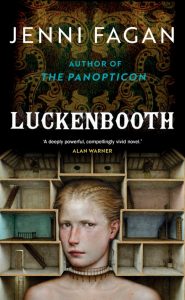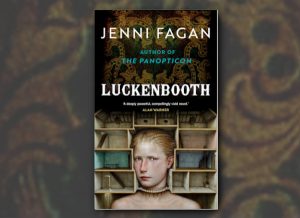LUCKENBOOTH by Jenni Fagan (BOOK REVIEW)
A Gothic Walk on the Wild Side
 In the eighteenth century, Edinburgh was home to the Scottish Enlightenment – the rule of reason, humanism, progress – but two hundred years later matters have gone into serious reverse. By 1910, in Jenni Fagan’s Luckenbooth, it provides the nesting ground for a grievous aspect of civilization: the unenlightened male id, nurtured on capitalist avarice.
In the eighteenth century, Edinburgh was home to the Scottish Enlightenment – the rule of reason, humanism, progress – but two hundred years later matters have gone into serious reverse. By 1910, in Jenni Fagan’s Luckenbooth, it provides the nesting ground for a grievous aspect of civilization: the unenlightened male id, nurtured on capitalist avarice.
This might be unfair to Edinburgh; it is not the city per se that is responsible but what happens inside the nine-storey house at 10 Luckenbooth. Jessie arrives at a first-floor flat there, having journeyed across the sea in a coffin that her devilish father had carpentered as her bed. He has been paid by a Mr Udnam, a landlord as hypocritical as Casby in Little Dorrit in his pretence as a do-gooder to render his daughter as a surrogate mother.
The second chapter moves up one floor in space and eighteen years in time, to the home of Flora who is attending a drag ball but remembering a past lover: ‘He was eternity and she was the beginning of time. They had travelled 12.9 billion years to meet each other.’ This is not science fiction but an example of the novel’s metaphoric prose when evoking a mental state of mind. A third chapter moves up one floor again and 11 years in time, introducing a Black American who lives there but works in Edinburgh’s veterinary institute cataloguing bones but building a mermaid skeleton on the side.
The author has a Hegel-like fascination with threefold structures: the spatial and temporal divisions separating the first three chapters are reset two more times and with the same characters. The next nine chapters, making up book’s second part, consist similarly of three chapters, again reset twice – but with three new characters occupying floors four, five and six of the building and moving ahead to the 1940s, ‘50s and ‘60s. The reader can make a good guess at the shape of the final part of the book that climaxes with a scene of mayhem and murder worthy of a South Korean horror movie.
The geometric precision of the book’s structure indicates coherence and logic but don’t be deceived by this. Numerology does not come into it and the saying that there’s nowt so queer as folk cannot do justice to the crazy variety of the twelve characters passing through 10 Luckenbooth: a spy; a psychic; a druggy; a murderer; a miner with a fear of daylight; ghosts. As Jessie puts it, describing the house: ‘For hundreds of years, people going round and round the stairwell like the cogs of a clock. Past and present and future passing each other by. The dead, the living, the barely living and the cowards and the ordinary and the brave, winding round each other through time.’
Dot, a character in the final triptych, intuits the nature of the house with prophetic intent: ‘No. 10 Luckenbooth has a sickness in it that will take all its structures down soon enough and it is only a harbinger of something that will come on a far, far bigger scale one day.’
Luckenbooth is a novel for readers with sophisticated tastes – nouvelle cuisine served gothic style with fugu on the side – who like to take a walk on the wild side and explore a ‘psychic vampire’ of a house tucked down a dark wynd of Edinburgh.

